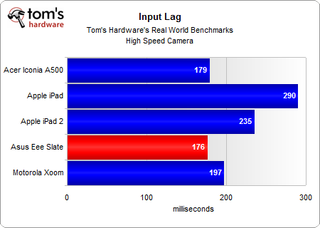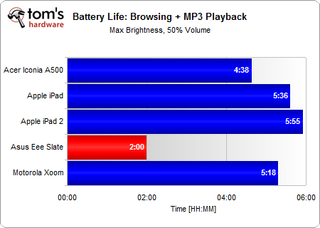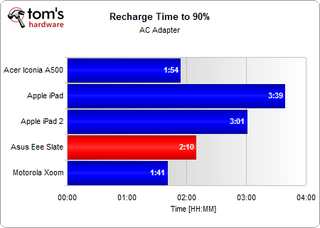Asus' Eee Slate EP121/B121: A Windows 7-Based Tablet PC
Real-World Performance Against Tablets
Real-World Benchmarks
While we could subject the Eee Slate to all of our Windows 7-based desktop benchmarks, it's more interesting to see how it fares against tablets when we apply the same real-world testing approach with a high-speed camera.

While Windows 7 is a much more feature-laden operating system than iOS or Android, the Eee Slate's powerful hardware is better-equipped to make short work of boot-up.

Once we fire up a Web browser, the combination of Windows 7 and Internet Explorer 9 finally make it clear how demanding a fully-featured operating environment can be. It takes twice as long to launch an IE9 window on the Eee Slate than our slowest tablet, Acer's Iconia A500. The iPad 2 is an undisputed champion in this metric.

Input lag is the time it takes from pressing a key to the time it takes for text to appear on the screen. This tells you how fast a tablet is registering an action. Ideally, you want low input lag so that you don't feel like the device is stuttering as you type or click buttons. The average college student has a reaction time of 200 milliseconds for visual stimuli, so there's no perceivable lag while you're using the touchscreen on the Eee Slate.
Battery Life
Testing a tablet’s battery life tends to be highly variable unless you control the entire experience from beginning to end. Cumulatively, touch gestures don’t have a great impact on battery life. The biggest factors are CPU/GPU processing, screen brightness, volume, and Wi-Fi use. In order to accurately measure battery life, I coded a script that automatically plays MP3s at 50% volume while browsing different Wikipedia pages every 12 minutes. This benchmark is probably overkill, but it gives you an idea of a worst-case scenario.
Stay on the Cutting Edge
Join the experts who read Tom's Hardware for the inside track on enthusiast PC tech news — and have for over 25 years. We'll send breaking news and in-depth reviews of CPUs, GPUs, AI, maker hardware and more straight to your inbox.


Recharge Time


Charging times are a double-edged sword. Ideally, you want a nice slow charge so that your battery lasts more than a few hundred cycles. Fast charge times keep you away from the wall socket longer, but in the long run they cut down on the health of the battery. Usually, the rate of charge starts to slow down somewhere in the 80% to 95% range, which is why the charging time from 0% to 10% is faster than 90% to 100%.
Current page: Real-World Performance Against Tablets
Prev Page PCMark 7: SSD Performance Disappointment Next Page Display Quality: Color Gamut-
Maziar Looks good but IMO,Win7 isn't designed for touch screens.Hopefully Win8 will add a decent touch UI to the OS which makes the Windows tablets more usefulReply -
I think thats the worst idea in tablet world; putting windows 7 on a tablet... dealing with sidebars even makes me sick on 24" screen with a hi-res mouse... I cant think of it on 12" screen with fingers... and thats already tried and failed a few years ago; tablet PC's... Will somebody take any lesson from failed ideas? or even from Ipad's success? Grow-up and see what's happening... or leave it all to Apple...Reply
-
back_by_demand All this tells me is that the inevitable rise of Fusion or Sandybridge with integrated graphics, or ION based tablets, Windows 8 will steal the show.Reply
When the hardware gets to a good enough standard then the peoiple will flock to a REAL operating system.
-
DjEaZy ... whardcore_gamerIntel HD graphics..that ruined everything... AMD's Fusion would be a better choice...Reply -
boiler1990 I'd like a W8 tablet that could simply change interfaces between the WP7-esque look in tablet mode and a W7-like interface with the addition of a keyboard dock (basically a W8 Transformer).Reply -
I current own a ASUS slate. For those who are interested in this tablet. Here is my suggestion. Get the 2G ram/32G SDD one. and upgrade the ram to 4G and intel X310 series 80G. the final price will be abour $50 more than 4G/64G one; however, u gain better SSD performace as well as more storage. I have been using this one for 3 monthes now, I would say, compare to wacom's other drawing table, this one still a little beyond, however, when u compare with Wacom's Cintiq12WX, Slate does provide the same function, without an extra computer. I would say 256 level vs 1024 level is a little trade off for convenience and price. As a graphic designer (not illustrator), i dont really find the 256 level is a huge issue. Tho if ASUS intend to relseae 2nd Gen of this product' i will be really interested in seeing them switch to AMD fusion. intel's HD chip is simply a joke. I would trade off some CPU power for more powerful graphic. Anyway, final thought.. this is the only table with pen function that can run Adobe CS5. I only hope it wont be hard to find the replacement battery...Reply
-
spsfinest Why is there no page for battery life? Was this thing such a poor performer you were to embarrassed for it to post the info Tom?Reply
Most Popular

